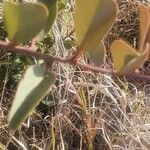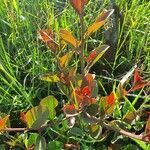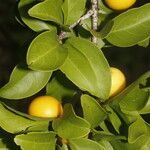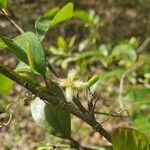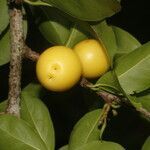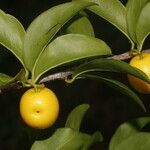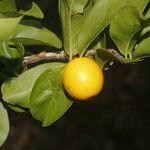Trees to 7 m. tall, the spines axillary branches, often leafy, usually stout. Leaves ovate, 3-11 cm. long, 2.0-4.5 cm. broad, retuse and mucronulate at the apex, obtuse to cuneate at the base, subcoriaceous, glabrous or bullate, the costa immersed above, emersed below, the primary lateral veins 3-6 pairs, most conspicu-ous towards the base of the lamina; petiole 5-7 mm. long, canaliculate. Inflores-cence umbellate, simple or compound, often fasciculate, multi-flowered, the bracts small, ciliate, caducous. Calyx crateriform, to 0.75 mm. long, about 1.5 mm. in diameter, 3-or 4-toothed, ciliate; petals 4, liguliform, 7-11 mm. long, 1.5-2.0 mm. broad, greatly reflexed, coriaceous, glabrous without, densely covered with red-brown barbed hairs within, white and often purple tipped; stamens 8, sub-exserted, the anthers linear, 3.0-4.5 mm. long, 0.5-0.75 mm. broad, the filaments 3.0-4.5 mm. long, glabrous; ovary long-conical, 3-4 mm. long, 1.0-1.5 mm. in diameter, glabrous, the style 3.0-4.5 mm. long; pedicel 5-6 mm. long. Drupe ellipsoid, 2-3 cm. long, 1.5-2.5 cm. in diameter, pale yellow.
Thorny, glabrous shrubs or trees to 10.5 m. Leaves narrowly or broadly elliptic to lanceolate, ovate, obovate, or orbiculate, retuse or obtuse, occasionally acute, emucronulate or with mucro to 0.5(-1.0) mm, 1.3-10.0 cm long, 0.8-6 cm wide, membranous to coriaceous, glaucous or not glaucous; petioles 2.5-12.0 mm long. Inflorescences umbels, subumbellate racemes, or cymes of 2-10 flowers, or flowers solitary; peduncles (when present) 1-15 mm long; pedicels 2-12 mm long, ebracteolate or, when flowers solitary, 2-to 4-bracteolate near the middle. Flowers functionally bisexual; sepals 4(-5), 0.5-1.4 mm long, ciliate or eciliate; petals 4(-5), 4.5-8.5(-12.0) mm long, densely white-bearded inside to within 1-3 mm of petal apex, eciliate, white to yellowish-green; stamens 8, filaments 1-4 mm long, anthers 1.8-4.0 mm long; ovary lanceoloid, 2.4-3.7 mm long, style (0.2-)0.5-4.3(-5.5) mm long (sometimes absent). Drupe ellipsoid, ovoid or globoid, 1.0-3.5 cm long, 1.1-3.0 cm in diameter, yellow, orange or red; seed ellipsoid, 1.5-2.5 cm long, 1-2 cm diameter.
Scrambling shrub or small tree to 5 m high, glabrous except corolla. Bark smooth or fissured, brown. Spines sometimes present. Leaves elliptic to obovate, succulent, obtuse or slightly emarginate, flat; lamina mostly 3–5 cm long and 1–3.5 cm wide; lateral nerves evident; petiole 5–9 mm long with 2 ridges decurrent from lamina. Peduncle and pedicels striate; peduncle 5–9 mm long; pedicels 3–5 mm long; bracts 1 mm long. Calyx 1 mm long. Corolla 7 mm long, white to pale yellow, densely bearded inside in lower 3/4; apical thickening papillose. Stamens 6 mm long; filaments slender, 4 mm long. Pistil 5 mm long; style 2.5 mm long. Drupe pyriform or globular, 17–25 mm long; exocarp yellow.
A small tree or spiny shrub about 3-4 m high. It has spines about 1 cm long which are thin and straight. The leaves and branches are without hairs. The leaves are alternate, oval and about 2-4 cm long. The leaves are bluish green. The leaves fold upwards along the midrib. The tip of the leaf can be round or with a notch. The flowers are greenish white, have a smell and are less than 1 cm long. They occur in small branched clusters with a common stalk. The fruit are yellow, egg shaped and 2 cm across. They are thin skinned. They are sour. There is one large seed.
Shrub or tree, 2-4 m tall. Branchlets usually spiny. Petiole 3-5 mm; leaf blade ovate, elliptic, or obovate, 3-5 × 2-3 cm, ± leathery, base obtuse, apex obtuse, apiculate, mucronulate, or sometimes emarginate; secondary veins 3-5 on each side of midvein. Cymes or racemes 1.5-2.5 cm, 3-6-flowered. Pedicel 2-3 mm. Calyx cupular, ca. 1 mm. Petals 4 or 5, white or greenish, oblong, 5-7 mm, inside white-barbate. Stamens 8 or 10. Ovary ovoid-conic. Drupe orange, ± globose to ovoid, 2-3 cm in diam. Fl. and fr. Mar-Jun.
Leaf-lamina 2–8 × 1–4 cm., oblong-elliptic, obtuse to retuse at the apex, coriaceous; midrib impressed above, prominent below; lateral nerves 3–6 pairs, subinconspicuous on both surfaces; petiole 3–6 mm. long, canaliculate, puberulous or pubescent above.
Spiny shrub or small tree, up to 5 m high. Leaves 20-80 x 10-40 mm, glaucous. Flowers in pedunculate cymes. Fruit soid or subglobose. Flowers white.
Flowers in pedunculate racemose or umbelliform cymes; pedicels 3–7 mm. long; buds ellipsoid or oblong-obovoid.
Shrub or small tree up to 5 m. tall, glabrous, usually spiny; branches divaricate or more rarely ascendent.
Fruit c. 2·5 cm. in diam., drupaceous, yellow when ripe, ellipsoid or subglobose, edible.
Petals 4 (5), 5–10 × 1–2·5 mm., glabrous outside, densely bearded within, apiculate.
Ovary c. 3 × 1·5 mm.; style 1–2 mm. long, columnar, caducous.
Stamens 8; filaments 2–4 mm. long; anthers 2–4 × 0·4–0·8 mm.
Calyx 4 (5)-lobed, with ± slightly ciliate margins.
A glabrous shrub or small tree
Seed c. 1·5 cm. in diam.
A yellow plum-like fruit
White fragrant flowers

